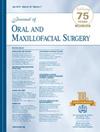What Are the Complications of Temporomandibular Joint Arthrocentesis?
IF 2.3
3区 医学
Q2 DENTISTRY, ORAL SURGERY & MEDICINE
引用次数: 0
Abstract
Background
Arthrocentesis is a minimally invasive procedure for treating intra-articular temporomandibular disorders. While it is considered relatively safe, like any surgical intervention, it carries potential risks.
Purpose
The study purpose was to estimate the frequency of complications associated with temporomandibular joint arthrocentesis, identify risk factors, and improve preparedness for effective prevention and management strategies.
Study design
In this retrospective cohort study, the investigators analyzed data from patients who underwent arthrocentesis treatment between 2015 and 2024 at Ondokuz Mayıs University, Faculty of Dentistry. Inclusion criteria were a diagnosis of painful intra-articular temporomandibular disorders. Patients with prior temporomandibular joint surgery or systemic conditions affecting joint function were excluded.
Independent variable
The independent variables included age, sex, and the presence of unilateral or bilateral arthrocentesis.
Main outcome variables
The main outcome variables are major (intervention required) and minor (no intervention) complications observed during the procedure and in the early follow-up period in patients. These complications include fluid extravasation, minor bleeding, transient facial paralysis, subcutaneous emphysema, external auditory fluid, and preauricular inflammation.
Covariates
Not applicable in this study.
Analyses
Descriptive statistics were used to report the occurrence of complications. The χ2 test was used for categorical variables. As this is a case series, hypothesis testing is not feasible. A P value <.05 was considered statistically significant.
Results
The sample comprised 210 subjects (252 joints) with a mean age of 39.16 ± 14.59 (18-82 years). Nine (4.29%) were male, and 201 (95.71%) were female. Major and minor complication rates observed in patients are 2.84 and 28.1%, respectively. The distribution of complications in the treated joints is as follows: fluid extravasation (25.71%), transient facial paralysis (14.28%), minor bleeding (1.9%), subcutaneous emphysema (0.47%), fluid outflow from the ear (0.95%), and preauricular infection (1.42%). A statistically significant relationship was found between transient facial paralysis and fluid extravasation (P < .001). Bilateral arthrocentesis was defined as a risk factor (P = .003). No significant relationship was found between the independent variables and complications.
Conclusions and relevance
The findings indicate that complications during and after arthrocentesis are common but manageable. Understanding these complications and their frequencies is crucial for surgeons to know the associated risks.
颞下颌关节置换术中及术后早期并发症有哪些?
背景:关节穿刺是一种治疗关节内颞下颌关节紊乱的微创手术。虽然与任何外科手术一样,它被认为是相对安全的,但它也有潜在的风险。目的:本研究的目的是评估颞下颌关节穿刺相关并发症的发生率,识别危险因素,并为有效的预防和管理策略做好准备。研究设计:在这项回顾性队列研究中,研究人员分析了2015年至2024年在Ondokuz Mayıs大学牙科学院接受关节穿刺治疗的患者的数据。纳入标准是诊断为疼痛的关节内颞下颌紊乱。既往有颞下颌关节手术或影响关节功能的全身性疾病的患者被排除在外。自变量:自变量包括年龄、性别、单侧或双侧关节穿刺的存在。主要结局变量:主要结局变量是患者在手术过程中和早期随访期间观察到的严重(需要干预)和轻微(不需要干预)并发症。这些并发症包括液体外渗、少量出血、一过性面瘫、皮下肺气肿、外耳液和耳前炎症。协变量:本研究不适用。分析:采用描述性统计方法报告并发症的发生情况。分类变量采用χ2检验。由于这是一个案例系列,假设检验是不可行的。结果:210例患者(252个关节),平均年龄39.16±14.59(18-82岁)。男性9例(4.29%),女性201例(95.71%)。患者主要并发症发生率为2.84%,次要并发症发生率为28.1%。治疗关节并发症的分布为:液体外渗(25.71%)、一过性面瘫(14.28%)、少量出血(1.9%)、皮下肺气肿(0.47%)、耳外液(0.95%)、耳前感染(1.42%)。结论和相关性:研究结果表明,关节穿刺期间和之后的并发症是常见的,但是可控的。了解这些并发症及其发生频率对外科医生了解相关风险至关重要。
本文章由计算机程序翻译,如有差异,请以英文原文为准。
求助全文
约1分钟内获得全文
求助全文
来源期刊

Journal of Oral and Maxillofacial Surgery
医学-牙科与口腔外科
CiteScore
4.00
自引率
5.30%
发文量
0
审稿时长
41 days
期刊介绍:
This monthly journal offers comprehensive coverage of new techniques, important developments and innovative ideas in oral and maxillofacial surgery. Practice-applicable articles help develop the methods used to handle dentoalveolar surgery, facial injuries and deformities, TMJ disorders, oral cancer, jaw reconstruction, anesthesia and analgesia. The journal also includes specifics on new instruments and diagnostic equipment and modern therapeutic drugs and devices. Journal of Oral and Maxillofacial Surgery is recommended for first or priority subscription by the Dental Section of the Medical Library Association.
 求助内容:
求助内容: 应助结果提醒方式:
应助结果提醒方式:


